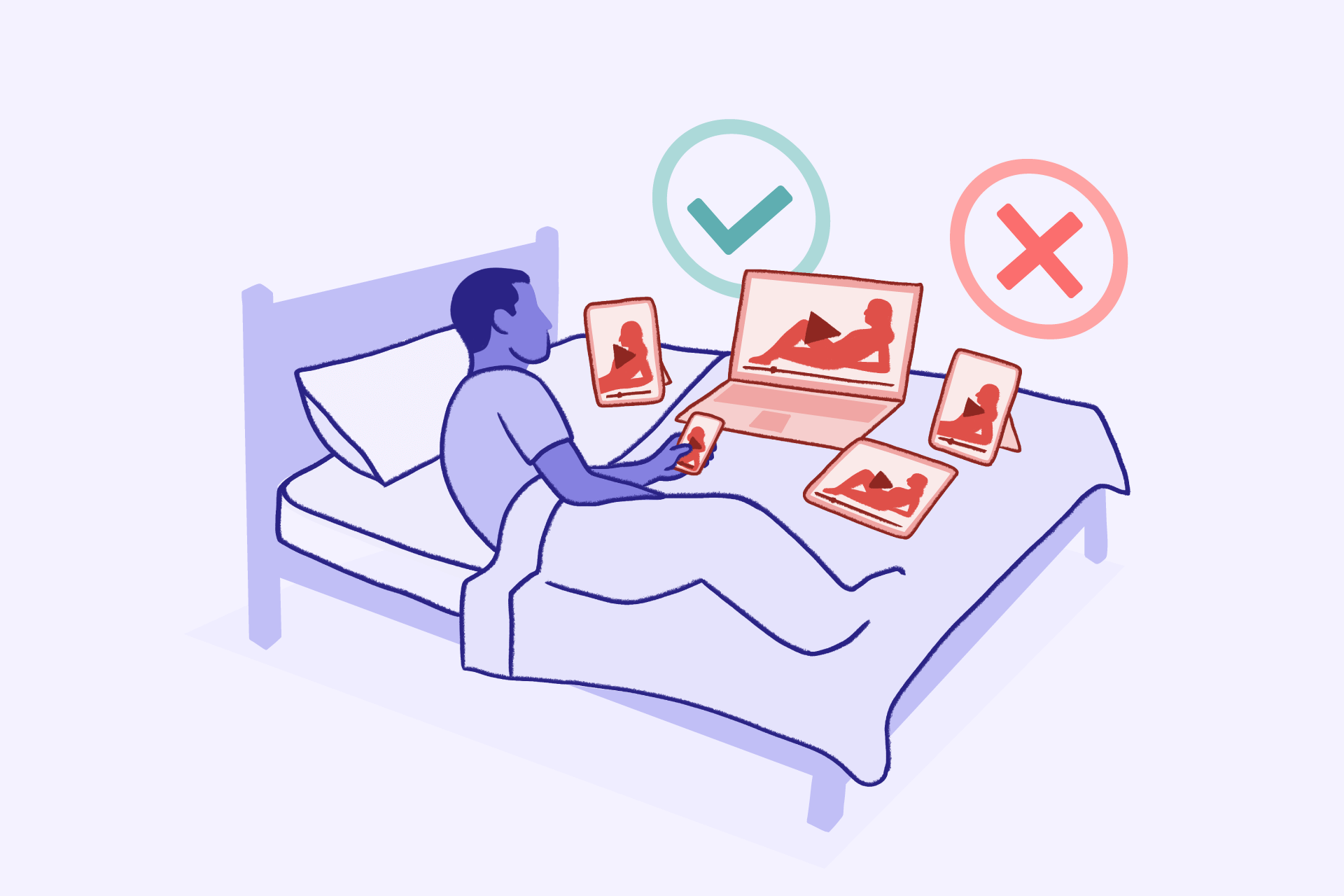Porn Addiction Test: 10 Questions to Learn More About Your Behavior



Caroline Beidler, MSW is an author, speaker, and the Managing Editor of Recovery.com. She writes about topics related to addiction, mental health, and trauma recovery, informed by her personal experience and professional expertise.




Caroline Beidler, MSW is an author, speaker, and the Managing Editor of Recovery.com. She writes about topics related to addiction, mental health, and trauma recovery, informed by her personal experience and professional expertise.
Table of Contents
When viewing porn becomes compulsive, secretive, or begins to interfere with daily life, it may be time to ask a deeper question: Is this a habit or something more?
The porn addiction test is a self-assessment tool designed to help you reflect on your pornography use and whether it shows signs of a potential behavioral addiction. Based on research and tools like the Sexual Addiction Screening Test (SAST), this quiz offers a starting point for clarity, not judgment.
Disclaimer: This tool is not a diagnosis. It is a screening tool meant to increase self-awareness. If you’re concerned about your results or your mental health, speak with a qualified mental health professional or healthcare provider.
Why Take a Porn Addiction Self-Assessment?
Not all porn consumption is harmful. But if you’re feeling ashamed, anxious, or stuck in a cycle of cravings, self-soothing, and regret, it might be time to take a closer look.
This self-assessment can help you:
- Identify possible signs of porn addiction
- Reflect on how viewing pornography may be affecting your self-worth, relationships, or productivity
- Recognize emotional or psychological patterns tied to porn habits
- Decide whether additional support or addiction treatment could help
You don’t have to “hit bottom” to explore your relationship with porn. A test can prompt reflection long before a mental health condition develops or intensifies.
Common Signs of Porn Addiction
Porn addiction, sometimes referred to as pornography addiction, is not formally listed in the Diagnostic and Statistical Manual of Mental Disorders (DSM-5), but many clinicians recognize it as a type of behavioral addiction with patterns similar to substance use disorder.
People struggling with problematic porn use often experience:
- Cravings or intense urges to watch porn, especially when feeling stressed or lonely
- Escalation in frequency or intensity of pornography consumption
- Using masturbation and porn to regulate emotions or escape
- Attempts to quit or reduce porn use, followed by relapse
- Feelings of guilt, shame, or frustration after watching porn
- Impact on self-esteem, relationships, or sexual function
- Neglecting responsibilities, work, or family members due to time spent viewing porn
These signs can gradually erode a person’s wellness, and many individuals report feeling trapped in a loop of compulsion, secrecy, and regret.
How the Porn Addiction Test Works
The porn addiction test typically includes 15–25 questions that explore emotional, behavioral, and situational patterns tied to pornography. It draws from established tools used in assessing sex addiction, compulsive sexual behavior, and related mental health disorders.
Questions may include:
- Do you feel unable to control your porn habits?
- Have you ever lied to a loved one or partner about your porn consumption?
- Do you continue to watch porn despite negative effects on your daily life or mental health?
- Do you use porn as a way to cope with anxiety, depression, or boredom?
- Has your porn use interfered with sexual satisfaction in real-life sexual activities?
Your score reflects whether your patterns might warrant further evaluation or intervention from a mental health professional.
What If You Score High?
A high score doesn’t mean you’re “addicted” in a clinical sense, but it does indicate that your use of pornography may be affecting your life in ways worth addressing.
Here Are Practical Next Steps to Consider:
- Talk to a licensed mental health professional, especially one experienced in behavioral addictions or sexual health.
- Explore treatment programs that address pornography addiction, often through cognitive-behavioral therapy (CBT), trauma-informed care, or group therapy.
- Identify co-occurring conditions, such as anxiety, depression, or substance misuse, that may be reinforcing your porn habits.
- Join a support group, such as Sex Addicts Anonymous (SAA), Porn Addicts Anonymous (PAA), or SMART Recovery for behavioral issues.
- Practice digital hygiene—limit social media exposure or install blocking software to reduce online porn temptation.
The test offers direction, not diagnosis. What you do next is what makes the difference.
When Porn Use Becomes a Problem
You may not feel like viewing porn is inherently wrong or harmful. But like other behaviors such as eating, shopping, or scrolling on social media, it can become excessive or compulsive.
Porn use may become problematic if:
- You skip social outings, work deadlines, or sleep to view porn.
- Your sexual behavior offline is affected (e.g., difficulty with arousal or intimacy).
- You find yourself stuck in a cycle of porn consumption, guilt, and secrecy.
- You feel out of control and unsure how to stop.
These experiences are not a reflection of weakness. They’re signals that something deeper may be driving the behavior.
Porn Addiction and Mental Health
Pornography addiction is rarely about porn alone. It’s often tied to emotional regulation, past trauma, or unmet psychological needs.
For example:
- People with low self-esteem may seek validation through masturbation fantasies.
- Someone with a mental health condition like depression may use porn to feel stimulated or distracted.
- Those with unresolved trauma may seek control or numbing through fantasy
Long-term compulsive porn use has been associated with increased risk for:
- Emotional dysregulation.
- Anxiety and depression.
- Erectile dysfunction or reduced libido.
- Distorted views of sex, intimacy, or gender roles.
That’s why addressing porn addiction often means looking beyond the screen.
What the Porn Addiction Test Can—and Can’t—Tell You
What it can do:
- Offer insight into problematic pornography use.
- Highlight risk factors for behavioral addictions.
- Motivate you to seek out treatment options or therapeutic support.
What it can’t do:
- Diagnose porn addiction or other mental health disorders.
- Consider your trauma history, culture, or personal values.
- Replace the expertise of a mental health professional or healthcare provider.
Self-assessments are valuable tools, but their most significant strength is pointing you toward the next steps.
Who Should Take the Porn Addiction Test?
Consider taking the quiz if you:
- Feel out of control or distressed by your porn habits.
- Use porn to escape emotions or stress.
- Notice a decline in self-esteem, focus, or real-life intimacy.
- Are exploring whether watching porn has become compulsive.
- Want to support a loved one who may be struggling with their porn use.
It’s not about proving you have a problem. It’s about recognizing when something in your daily life is no longer serving your health.
Treatment and Support That Work
There’s no universal path to healing, but evidence-based care for pornography addiction includes:
- Cognitive-behavioral therapy (CBT) to reshape beliefs, triggers, and behavioral patterns.
- Psychotherapy to explore underlying issues such as trauma, attachment, or shame.
- Group therapy to reduce isolation and provide accountability.
- Digital detox strategies to interrupt automatic viewing behavior.
- Mindfulness-based relapse prevention to develop healthier coping skills.
Many people benefit from integrated treatment programs that combine behavioral health support with community and wellness practices.
Whether you’re struggling yourself or worried about someone close to you, support is available. Healing doesn’t require perfection. It starts with awareness, honesty, and the courage to ask for help.
Resources and Next Steps
If you or someone you love is struggling with compulsive pornography use, or other mental health concerns like anxiety, help is available. Use Recovery.com to find pornography treatment centers near you, compare levels of care, and connect with programs that address both addiction and co-occurring disorders so you can start building a healthier life.
FAQs
Our Promise
How Is Recovery.com Different?
We believe everyone deserves access to accurate, unbiased information about mental health and recovery. That’s why we have a comprehensive set of treatment providers and don't charge for inclusion. Any center that meets our criteria can list for free. We do not and have never accepted fees for referring someone to a particular center. Providers who advertise with us must be verified by our Research Team and we clearly mark their status as advertisers.
Our goal is to help you choose the best path for your recovery. That begins with information you can trust.









